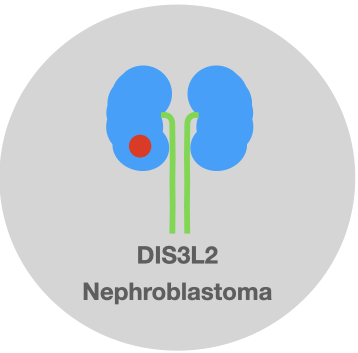DIS3L2 Mutations and Predisposition to Nephroblastoma: Evidence of Associations Through Patient Cases and Cohort Studies

Introduction
Nephroblastoma, commonly known as Wilms tumor, poses a significant health challenge in pediatric oncology. Recent advances have revealed compelling evidence of the association between DIS3L2 gene mutations and an increased predisposition to nephroblastoma. In this comprehensive blog post, we delve into the world of patient cases and cohort studies, drawing upon evidence from the Nucleati Germline Cancer Evidence Base. By exploring these real-life scenarios and robust research, we aim to shed light on the intriguing connections between DIS3L2 mutations and nephroblastoma predisposition. Join us on this enlightening journey as we unravel the genetic puzzle through compelling evidence derived from patient cases and cohort studies.
Reported single patient studies with DIS3L2 mutations
| Patient/Family | Gene/Variation | Clinical Characteristics | HGVS(es) | Citation |
|---|---|---|---|---|
| Japanese patient with Perlman syndrome | Deletion of exon 9 of DIS3L2 | Rare, autosomal recessive overgrowth disorder | exon 9 deletion | PubMed |
| 6-year-old Japanese female patient with Perlman syndrome | DIS3L2 (c.[367-2A>G];[1328T>A]) | Perlman syndrome is a rare overgrowth syndrome characterized by polyhydramnios, macrosomia, distinctive facial appearance, renal dysplasia, and a predisposition to Wilms' tumor. | NM_152383.5(DIS3L2):c.367-2A>G, NM_152383.5(DIS3L2):1328T>A (p.Met443Lys) | PubMed |
| 2-year-old boy with Wilms tumor and CMTC | DIS3L2 germline mutation | Patient with both Wilms tumor and CMTC | NM_152383.5(DIS3L2):c.695C>G (p.Ser232Ter) | PubMed |
Evidence from cohort studies
| Cohort | Setup | Outcome | HGVS(es) | Citation |
|---|---|---|---|---|
| 96 Wilms tumor samples | Genetic and epigenetic analyses guided by high resolution whole-genome SNP array | Identified genes with a possible role in WT development, including MYCN, DIS3L2, MIR562, HACE1, GLI3, CDKN2A and CDKN2B, PALB2, and CHEK2 | NM_152383.5(DIS3L2):c.410A>G (p.Tyr137Cys) | PubMed |
| Wilms tumor (WT) patients were diagnosed in the Netherlands between 2015 and 2020. | (Epi)genetic predisposing factors affecting WT predisposing genes and loci investigated through targeted diagnostic testing, germline (trio-)whole-exome sequencing, and Beckwith-Wiedemann spectrum (BWSp) testing on normal kidney-derived DNA. | (Epi)genetic predisposing factors were present in 33.3% of patients, including heterozygous DIS3L2 variants in 4% of patients with a second somatic hit in 4 of 5 tumors. 16% of patients were diagnosed with BWSp, and several candidate WT predisposition genes were identified. | NM_152383.5:c.2510_2513delinsGA (p.Phe837Ter), NM_152383.5:c.1096G>T (p.Glu366Ter) | PubMed |
| Individuals with Perlman syndrome | DIS3L2 germline mutations | Congenital overgrowth syndrome inherited in an autosomal recessive manner associated with Wilms tumor susceptibility | NM_152383.5(DIS3L2):c.2219del (p.Asn740fs), NM_152383.5(DIS3L2):c.86del (p.Gly29fs), NM_152383.5(DIS3L2):c.2335_2394+30del, NM_152383.5(DIS3L2):c.2088C>G (p.Tyr696Ter), NM_152383.5(DIS3L2):c.2394+1G>A, NM_152383.5(DIS3L2):c.581C>G (p.Ser194Ter), NM_152383.5(DIS3L2):c.375del (p.Lys125fs), NM_152383.5(DIS3L2):c.363G>A (p.Trp121Ter), NM_152383.5(DIS3L2):c.264+1del, NM_152383.5(DIS3L2):c.48del (p.Arg17fs), NM_152383.5(DIS3L2):c.601+1G>A, NM_152383.5(DIS3L2):c.973C>T (p.Gln325Ter), NM_152383.5(DIS3L2):c.580_581del (p.Val195fs), NM_152383.5(DIS3L2):c.1787dup (p.Ile597fs), NM_152383.5(DIS3L2):c.274C>T (p.Arg92Ter), NM_152383.5(DIS3L2):c.1836del (p.Gln614fs), NM_152383.5(DIS3L2):c.1810C>T (p.Gln604Ter), NM_152383.5(DIS3L2):c.1983del (p.Thr662fs), NM_152383.5(DIS3L2):c.1162C>T (p.Arg388Ter), NM_152383.5(DIS3L2):c.505C>T (p.Gln169Ter), NM_152383.5(DIS3L2):c.1740-1G>C, NM_152383.5(DIS3L2):c.2041C>T (p.Gln681Ter), NM_152383.5(DIS3L2):c.1573del (p.Val525fs), NM_152383.5(DIS3L2):c.645del (p.Cys216fs), NM_152383.5(DIS3L2):c.541dup (p.Ile181fs), NM_152383.5(DIS3L2):c.1096G>T (p.Glu366Ter), NM_152383.5(DIS3L2):c.733C>T (p.Arg245Ter), NM_152383.5(DIS3L2):c.2270del (p.Phe757fs), NM_152383.5(DIS3L2):c.1447C>G (p.Arg483Gly), NM_152383.5(DIS3L2):c.1570G>T (p.Glu524Ter), NM_152383.5(DIS3L2):c.2289+1G>A, NM_152383.5(DIS3L2):c.820C>T (p.Arg274Ter), NM_152383.5(DIS3L2):c.285dup (p.Ile96fs), NM_152383.5(DIS3L2):c.1859_1866del (p.Asp620fs), NM_152383.5(DIS3L2):c.1403G>A (p.Trp468Ter), NM_152383.5(DIS3L2):c.1879_1882del (p.Gln627fs), NM_152383.5(DIS3L2):c.695C>G (p.Ser232Ter), NM_152383.5(DIS3L2):c.127C>T (p.Arg43Ter), NM_152383.5(DIS3L2):c.1923+1G>A, NM_152383.5(DIS3L2):c.702+1G>A, NM_152383.5(DIS3L2):c.2394+1G>T, NM_152383.5(DIS3L2):c.2088del (p.Leu695_Tyr696insTer), NM_152383.5(DIS3L2):c.325dup (p.Asp109fs), NM_152383.5(DIS3L2):c.1924-1G>T, NM_152383.5(DIS3L2):c.1556_1565del (p.Glu519fs), NM_152383.5(DIS3L2):c.799_800del (p.Leu267fs) | PubMed |
Summary
This blog post provides a examination of the association between DIS3L2 gene mutations and an increased susceptibility to nephroblastoma. Through the analysis of patient cases and cohort studies sourced from the Nucleati Germline Cancer Evidence Base, we present compelling evidence that supports the link between DIS3L2 mutations and nephroblastoma predisposition. By delving into the specific details of patient cases and drawing insights from large-scale cohort studies, we compiled evidence of associations between DIS3L2 mutations and nephroblastoma.
Conclusion
The evidence compiled from patient cases and cohort studies establishes supportive/strong association between DIS3L2 gene mutations and an increased predisposition to nephroblastoma. By systematically analyzing case reports and cohort studies identified Nucleati Germline Cancer Evidence Base, we gain valuable insights into the genetic landscape of DIS3L2 mutations and nephroblastoma. This knowledge may help to lay a strong foundation to solidify the associations. As we continue to explore the intricate mechanisms underlying DIS3L2 mutations and their impact on nephroblastoma development, we move closer to more effective interventions and better outcomes for children affected by this challenging malignancy.